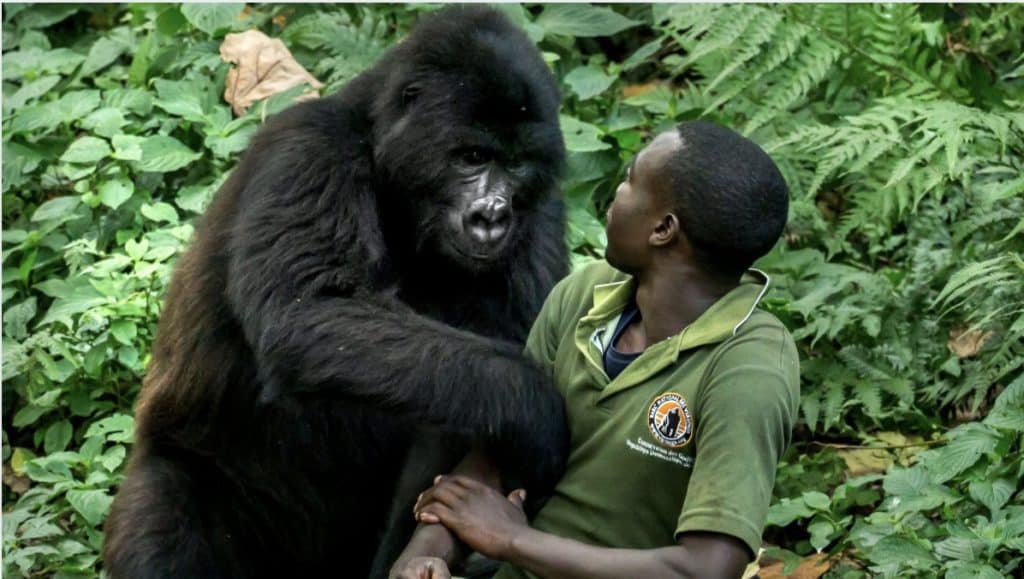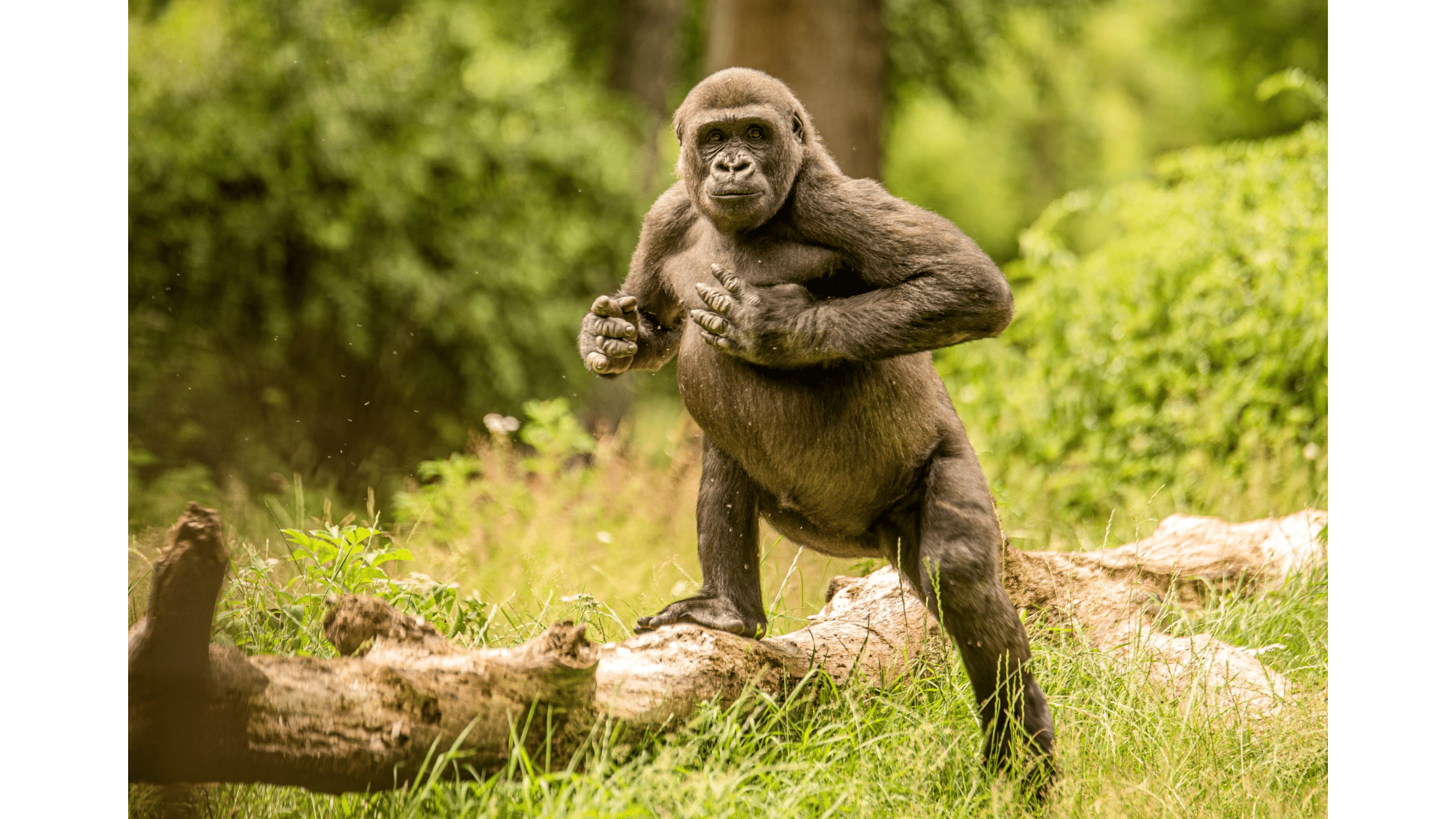What would you do if you saw a gorilla?
Many people think gorillas are dangerous because of movies and TV shows. But are they really?
The truth might surprise you.
Gorillas are strong, but they are also calm, shy, and usually avoid people. They don’t want to fight unless they feel scared or need to protect their family.
In this blog, you will learn what gorillas are really like, why they act the way they do, and how to stay safe if you ever see one.
Let’s bust the myths and discover the gentle side of gorillas.
Understanding Gorilla Nature
Gorillas are critically endangered primates found only in the misty mountains of East Africa.
With fewer than 1,000 individuals remaining in the wild, these magnificent apes face numerous threats but remain tough symbols of conservation success.
- Natural Temperament: Despite their formidable appearance, gorillas are generally shy and reserved.
- Social Structure: Family-oriented troops led by protective silverbacks.
- Diet and Lifestyle: Primarily vegetarian, spending most of their day foraging peacefully.
- Communication: A Simple system of vocalizations, body language, and facial expressions.
Different Species with Different Behaviors
The gorilla family includes several subspecies, each with slightly different behavioral tendencies:
| Species | Typical Behavior Toward Humans | Conservation Status |
|---|---|---|
| Mountain Gorillas | Most habituated to humans, generally calm | Endangered |
| Western Lowland Gorillas | Naturally more shy, less encountered | Critically Endangered |
| Eastern Lowland Gorillas | Less exposure to humans, more wary | Critically Endangered |
| Cross River Gorillas | Extremely rare, highly elusive | Critically Endangered |
Can Gorillas Attack Human Beings?
Yes, gorillas can attack humans. But such incidents are rare. Gorillas are generally shy, gentle, and non-aggressive by nature.
They live in tight-knit groups and prefer to avoid conflict, especially with humans. However, like any wild animal, they may become aggressive if they feel threatened, cornered, or if their group, especially infants, is in danger.
Most gorilla attacks happen in self-defense. For example, a silverback (the dominant male) may charge at a perceived threat to protect his family.
These displays are often meant to scare rather than harm. Aggression is rare in captivity as well, but it can happen if a gorilla feels threatened or stressed.
To avoid such situations, wildlife experts always recommend keeping a safe distance, remaining calm, and respecting the animal’s space when observing gorillas in the wild or zoos.
1. Gorilla vs Human Behaviour
| Feature | Gorilla | Human |
|---|---|---|
| Nature | Calm, generally non-aggressive | Variable |
| Triggers for Attack | Threats to troops or territory | Emotions, provocation |
| Common Reaction | Bluff charge, vocalizations | Verbal/physical confrontation |
| Attack Frequency | Very rare | More frequent in social scenarios |
2. Common Triggers of Aggression
Gorillas are generally peaceful, but certain threats can trigger aggressive behavior in them. However, understanding these threats is vital for both gorilla conservation and human safety.
- Protection of Young: Gorillas fiercely defend their infants if they sense danger.
- Territorial Defense: Silverbacks protect their group’s territory, especially from intruders.
- Misinterpreted Human Behavior: Actions like direct eye contact or sudden movements may be seen as threats.
- Prior Negative Experiences: Gorillas with past trauma, such as poaching attempts, may respond aggressively.
- Disease: Sharing 98% of our DNA, gorillas are vulnerable to human diseases, even common colds.
- Climate Change: Warmer temperatures and unpredictable rainfall disrupt gorillas’ food sources and habitats.
3. Gorilla Behavior
While they may look intimidating, gorillas tend to avoid confrontation unless provoked or highly stressed.
In the Wild:
- Gorillas generally flee from humans when threatened.
- Displays (like chest-beating) are meant to intimidate, not attack.
- Physical contact with humans is extremely rare.
In Captivity:
- Stress from confinement can lead to abnormal behavior.
- Familiarity with humans may reduce their natural caution.
- Aggression is rare but can occur under stress or fear.
Warning Signs and Gorilla Body Language
Gorillas use a variety of body movements and sounds to communicate their feelings and intentions. So, recognizing these signals can help you stay safe and understand their behavior better.
1. Chest Beating
Chest beating is a powerful and loud display where a gorilla pounds its chest with cupped hands. This behavior warns rivals or threats to stay away. It’s a way to show off strength without physical fighting.
Fun Fact: Each gorilla’s chest-beating pattern is unique, helping group members recognize each other from a distance.
2. Mock Charging
When a gorilla suddenly charges and stops before reaching you, it’s bluffing to intimidate. This behavior helps avoid real conflict by showing dominance without violence.
Tip: Running may trigger the gorilla’s chase instinct, so stay still or slowly back away.
3. Loud Grunting or Roaring
Gorillas use loud vocal sounds like grunts, roars, or hoots to communicate alarm, stress, or aggression. These calls warn the troop about potential dangers or rivals nearby and help maintain group cohesion.
Did You Know? Some gorilla calls can be heard over a mile away, cutting through thick jungle noise.
4. Intense Staring
Direct, prolonged eye contact from a gorilla can indicate that it feels threatened or is trying to assert dominance. Unlike humans, staring back may be seen as a challenge, so it’s best to look away politely.
Helpful Hint: Lowering your gaze shows respect and reduces the chance of conflict.
5. Yawning with Teeth Exposed
When a gorilla yawns widely, showing its large canine teeth, it’s a warning sign to back off. This display demonstrates its powerful jaws and strength without needing to attack.
Interesting Note: A silverback’s bite is so strong it can crush tough plant stems and even small bones.
6. Standing Upright and Puffing Up
A gorilla may stand on its hind legs and puff out its fur to appear bigger and more intimidating. This is often done to warn off threats or during displays of dominance within the group.
Extra Insight: This posture makes them look twice as tall and more formidable to challengers.
Safety Guidelines for Gorilla Encounters
| Do’s | Don’ts |
|---|---|
| Stay calm and quiet | Do not scream or run |
| Follow your guide’s instructions | Don’t stare directly into their eyes |
| Keep a safe distance | Never try to touch or feed them |
| Crouch if a gorilla approaches | Don’t make sudden movements |
| Observe respectfully | Avoid loud noises or flash cameras |
The Bottom Line
While gorillas physically can attack humans, the circumstances under which this might occur are specific and relatively rare.
Understanding gorilla behavior, respecting their space, and following established guidelines dramatically reduces any potential risk.
The relationship between humans and gorillas remains complex, serving as a reminder of our connection to the natural world and our responsibility to protect these remarkable animals for future generations.






















